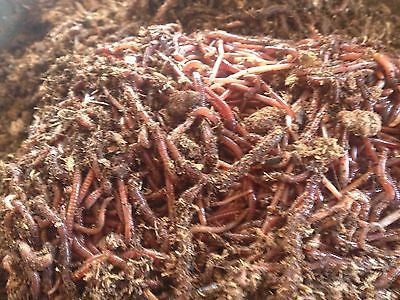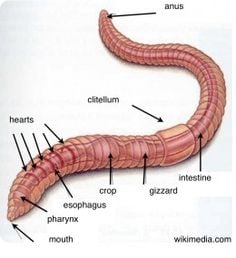Red Wiggler Worms - Natural Solution for Environment-friendly Composting
Red Wiggler Worms - Natural Solution for Environment-friendly Composting
Blog Article
Optimizing the Advantages of Red Wiggler Worms: A Comprehensive Handbook for Home Gardeners and Urban Farmers
In the world of lasting horticulture methods, red wiggler worms stand as unsung heroes, silently transforming organic waste into nutrient-rich castings that can work marvels for dirt health. As home gardeners and metropolitan farmers increasingly seek eco-friendly and cost-efficient ways to boost their gardens, the prospective advantages of taking advantage of the power of red wigglers can not be overemphasized. From minimizing kitchen area waste to growing healthier plants, the use of these modest animals offers a huge selection of advantages. By checking out the ins and outs of how to properly look after and make best use of the advantages of red wiggler worms, individuals can unlock a wide range of possibilities for boosting the sustainability and performance of their gardening ventures.
Recognizing Red Wiggler Worms
Red Wiggler worms, renowned for their reliable composting capabilities, are a species of earthworms extensively made use of in vermiculture techniques. These worms, medically known as Eisenia fetida, flourish in decomposing organic material, making them excellent prospects for composting.
One secret characteristic of Red Wiggler worms is their reproductive rate. These hermaphroditic creatures possess both female and male reproductive organs, allowing them to recreate rapidly under beneficial problems. A mature Red Wiggler can create multiple spawn in a short period, guaranteeing a constant populace within a composting system.

Setting Up a Worm Bin
When developing a worm container for vermiculture purposes, appropriate prep work and attention to information are crucial for developing a conducive setting for Red Wiggler worms,. Begin by selecting an ideal container for your worm bin. This can be a plastic or wood container with a lid to maintain dampness degrees and safeguard the worms from light. Make certain that the bin has water drainage holes at the base to stop waterlogging.

Location the worm container in a great, dark location far from direct sunshine and severe temperature levels. Frequently keep an eye on the moisture degrees, adding water if the bed linens really feels half-cracked or completely dry. Feed the worms a well balanced diet regimen of fruit and vegetable scraps, staying clear of citrus fruits, onions, and spicy foods. By following these steps, you can establish up a prospering worm bin that will successfully refine organic waste right into nutrient-rich vermicompost for your garden.
Feeding and Maintaining Worms
Making sure a balanced and healthy diet plan is essential for the wellness and performance of Red Wiggler worms in a vermiculture system. It is important to stay clear of feeding them citrus fruits, onions, garlic, milk products, meat, and oily foods as these can be harmful to the worms or cause undesirable smells in the bin.
Proper dampness degrees are additionally essential for the well-being of Red Wiggler worms. The bed linens needs to really feel like a wet sponge, supplying enough moisture for the worms to take a breath through their skin. Routinely check the wetness degrees and adjust by adding water or dry bed linen material as needed. Furthermore, maintaining proper temperature visit problems between 55-77 ° F(13-25 ° C )will certainly guarantee optimal worm task and recreation. By carefully monitoring their diet plan, dampness, and ecological conditions, home gardeners and urban farmers can sustain a efficient and healthy and balanced Red Wiggler worm populace for composting purposes.
Collecting Worm Spreadings
To efficiently draw out nutrient-rich worm castings from the vermicompost, a systematic harvesting process is vital for making the most of the composting benefits. Red Wiggler Worms. The initial step in harvesting worm castings is to encourage the worms to move to one side of the container. This can be achieved by placing fresh food scraps on one side and leaving the opposite uninterrupted for a few days. Once most of worms have actually relocated to the side with fresh food, the castings can be accumulated from the contrary side.
After the spreadings have been gathered, it is essential to separate any type of staying worms from the spreadings to stay clear of damaging them during storage or application. One reliable method is to create cone-shaped heaps of castings under intense light. Worms will naturally relocate far from the light, permitting for very easy separation and elimination.
Finally, the harvested worm spreadings should be stored in a trendy, dark, and dry area to keep their high quality and effectiveness as a nutrient-rich soil amendment. By complying with these actions, home garden enthusiasts and metropolitan farmers can optimize the benefits of red wiggler worms in their vermicomposting systems.
Utilizing Worm Castings in Gardening
The unification of nutrient-rich worm castings into yard soil can dramatically boost plant growth and total soil wellness. Worm castings, also referred to as vermicast, are an all-natural fertilizer created by red wiggler worms as they damage down organic issue. These castings are rich in essential nutrients like nitrogen, phosphorus, potassium, and useful microorganisms that advertise plant growth and boost dirt framework.
When using worm castings in gardening, it is necessary to mix them completely into the dirt or use them as a leading clothing around plants. The slow-release nature of worm castings makes certain a steady supply of nutrients to plants gradually, reducing the risk of nutrient leaching and promoting long-lasting soil fertility. Furthermore, worm spreadings aid enhance soil aeration, water retention, and microbial activity, creating a healthy setting for plant roots to prosper.

Conclusion
In final thought, the usage of red wiggler worms in home horticulture and urban farming can substantially profit dirt health and wellness and plant development. By comprehending how straight from the source to set up and maintain a worm container, feed the worms effectively, and harvest their nutrient-rich spreadings, gardeners can optimize the benefits of these earthworms.
In the realm of lasting horticulture practices, red wiggler worms stand as unsung heroes, silently changing organic waste right into nutrient-rich spreadings that can function wonders for soil health and wellness.When establishing a worm bin for vermiculture purposes, proper preparation and interest to detail are vital for producing a helpful atmosphere for Red Wiggler worms. The very first action in collecting worm spreadings is to motivate the worms to move to one side of the container. Worm castings, additionally known as vermicast, are a natural fertilizer produced by red wiggler worms as they break down organic matter. By comprehending how to set up and preserve a worm container, feed the worms this contact form appropriately, and harvest their nutrient-rich castings, gardeners can make best use of the advantages of these earthworms.
Report this page